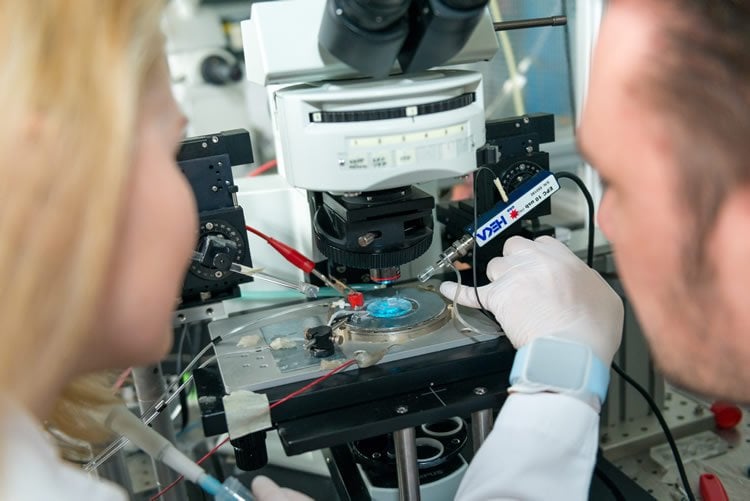Switching specific G-protein-coupled signalling pathways on and off.
Blue on, yellow off: using different-coloured light, researchers are able to switch signalling pathways in the brain on and off.
Researchers in Bochum have utilised light-sensitive proteins from nerve cells of the eye – so-called melanopsins – to switch on specific signalling pathways in brain cells with high temporal precision. Depending on what kind of melanopsin the researchers used, signalling pathways were switched on either transiently or sustained. In mammals, the protein typically regulates the circadian rhythm.
Dr Katharina Spoida, Dennis Eickelbeck, Prof Dr Stefan Herlitze and Dr Olivia Masseck from the Department of General Zoology and Neurobiology at the Ruhr-Universität Bochum (RUB), together with other colleagues from Bochum and researchers from the University of Osnabrück report in the journal “Current Biology”.
Comparison: melanopsin of mice and men
The researchers describe, for example, that melanopsins of mice and of men respond differently to light stimulation. Short blue light pulses activate mouse melanopsin permanently, but human melanopsin only temporarily. Both proteins can be switched off with yellow light.
“These light-sensitive proteins are the ideal basis for the development of optogenetic tools,” says Dennis Eickelbeck. In optogenetics, researchers make use of genetic manipulation to couple light-sensitive proteins to other proteins, thus generating receptors that can be controlled by light, for example.
Decoding G-protein signalling pathways
In the next step, the RUB researchers wish to develop G-protein-coupled receptors that can be activated by light. These receptors control a number of functions in the body. Which signalling pathway is switched on in the cell is determined by whether a G-protein is activated transiently or sustained. Changes to the G-proteins’ temporal activation patterns may result in serious diseases, for example obesity or cardio-vascular diseases.

Insights into the complex serotonin system
By controlling selected individual signalling pathways using optogenetic methods, the role they play in the healthy organism can be determined. Researchers may also be able to find out which signalling pathways affect the occurrence of certain diseases.
“In follow-up studies, we intend to couple various melanopsins to serotonin receptors and analyse in greater detail the way diseases are triggered by disturbances of the temporal sequence of G-protein signals,” reports Katharina Spoida, who was in charge of the current study, together with Dennis Eickelbeck.
Source: RUB
Image Credit: The image is credited to RUB, Kramer.
Original Research: Abstract for “Melanopsin Variants as Intrinsic Optogenetic On and Off Switches for Transient versus Sustained Activation of G Protein Pathways” by Katharina Spoida, Dennis Eickelbeck, Raziye Karapinar, Tobias Eckhardt, Melanie D. Mark, Dirk Jancke, Benedikt Valerian Ehinger, Peter König, Deniz Dalkara, Stefan Herlitze, and Olivia A. Masseck in Current Biology. Published online April 7 2016 doi:10.1016/j.cub.2016.03.007
Abstract
Melanopsin Variants as Intrinsic Optogenetic On and Off Switches for Transient versus Sustained Activation of G Protein Pathways
Highlights
•Melanopsin variants (h/mOpn4L) are one-component, tristable optogenetic tools
•hOpn4L and mOpn4L switch on/off GPCR pathways by blue/yellow light
•mOpn4L induces sustained, whereas hOpn4L induces transient, G protein activation
•Opn4s switch neurons on/off with temporal precision and limited phototoxicity
Summary
G-protein-coupled receptors (GPCRs) represent the major protein family for cellular modulation in mammals. Therefore, various strategies have been developed to analyze the function of GPCRs involving pharmaco- and optogenetic approaches [ 1, 2 ]. However, a tool that combines precise control of the activation and deactivation of GPCR pathways and/or neuronal firing with limited phototoxicity is still missing. We compared the biophysical properties and optogenetic application of a human and a mouse melanopsin variant (hOpn4L and mOpn4L) on the control of Gi/o and Gq pathways in heterologous expression systems and mouse brain. We found that GPCR pathways can be switched on/off by blue/yellow light. The proteins differ in their kinetics and wavelength dependence to activate and deactivate G protein pathways. Whereas mOpn4L is maximally activated by very short light pulses, leading to sustained G protein activation, G protein responses of hOpn4L need longer light pulses to be activated and decline in amplitude. Based on the different biophysical properties, brief light activation of mOpn4L is sufficient to induce sustained neuronal firing in cerebellar Purkinje cells (PC), whereas brief light activation of hOpn4L induces AP firing, which declines in frequency over time. Most importantly, mOpn4L-induced sustained firing can be switched off by yellow light. Based on the biophysical properties, hOpn4L and mOpn4L represent the first GPCR optogenetic tools, which can be used to switch GPCR pathways/neuronal firing on an off with temporal precision and limited phototoxicity. We suggest to name these tools moMo and huMo for future optogenetic applications.
“Melanopsin Variants as Intrinsic Optogenetic On and Off Switches for Transient versus Sustained Activation of G Protein Pathways” by Katharina Spoida, Dennis Eickelbeck, Raziye Karapinar, Tobias Eckhardt, Melanie D. Mark, Dirk Jancke, Benedikt Valerian Ehinger, Peter König, Deniz Dalkara, Stefan Herlitze, and Olivia A. Masseck in Current Biology. Published online April 7 2016 doi:10.1016/j.cub.2016.03.007






